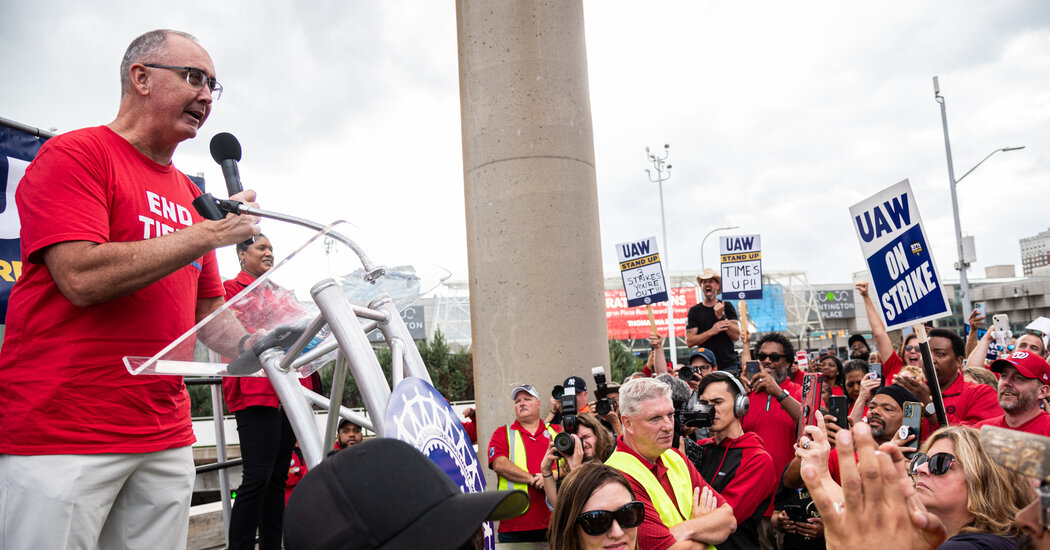on Automakers Exploring the Reasons Behind U.A.W. President’s Strict Negotiating Stance with Automakers
October 26, 2023 | by Kaju

When Shawn Fain sought the presidency of the United Automobile Workers union last year, he ran on a platform that promised: “No corruption. No concessions. No tiers.” That pledge encapsulated many members’ frustrations with years of union scandal and concessions to the three big Detroit automakers, including the creation of a lower tier of wages for newer employees. The platform helped propel Mr. Fain to the top job — where he has led a mounting wave of walkouts in recent weeks to demand more favorable contract terms. But the platform largely predated Mr. Fain’s candidacy. It was devised by a group called Unite All Workers for Democracy, which was officially formed in 2020 as a caucus — essentially, a political party within the union. The group set out to topple the ruling party, known as the Administration Caucus, which had run the union for more than 70 years. In 2022, Unite All Workers hashed out its party line, recruited candidates and ramped up a campaign operation to elect them.
When the dust settled, the slate had won half the seats on the union’s 14-member executive board, with Mr. Fain, previously a union staff member, as president. Unite All Workers’ role helps explain why the union has taken such a hard line with the automakers. “We had a platform we ran on, and we’re trying to push that platform forward,” said Scott Houldieson, a founder of the group and a longtime Ford Motor worker in Chicago. “Shawn has been really upfront about what we’re trying to accomplish.”
The first fruits of that approach may have emerged Wednesday, when negotiators for the union and Ford agreed on terms for a new four-year contract, including a wage increase of roughly 25 percent over the four years, according to the union. “We hit the companies to maximum effect,” Mr. Fain said in a Facebook livestream. The deal is subject to ratification by the company’s union workers.
Since at least the 1980s, U.A.W. members have formed groups to challenge the union’s top officials, or at least prod them to be more confrontational with automakers. The efforts took on added urgency in 2007, when the union accepted tiers as a way to stabilize the automakers’ financial footing. (General Motors and Chrysler later filed for bankruptcy anyway; Ford avoided it.)
But the Administration Caucus always held a trump card: The union leadership wasn’t elected directly by members. Rather, future leaders were effectively chosen by existing leaders, then approved by delegates to a convention every four years.
That changed after a corruption scandal in which two recent U.A.W. presidents were charged with embezzlement in 2020. As part of a consent decree with the federal government, members voted in a referendum on whether to directly elect union leaders. Unite All Workers, which was pressing for the change, waged an all-out campaign to persuade union members to support “one member one vote.”
When the initiative passed by nearly a two-to-one ratio, Unite All Workers, whose members paid an annual fee, was poised to become a kingmaker of sorts in the union’s 2022 elections. The group had a budget of over $100,000, two full-time staff members, and hundreds of volunteer organizers.
Unite All Workers announced that anyone who wanted to join its campaign slate would have to fill out a detailed questionnaire and attend at least one meeting with its members. The group wanted to ensure that the candidates it backed were committed to running the union with extensive input from rank-and-file members, and to driving a much harder bargain with employers. It wanted an end to wage tiers, which it said divided and demoralized workers, and a focus on organizing new members, especially among electric vehicle and battery workers.
Among those responding to the call was Mr. Fain, then a staff member in the union division responsible for Stellantis, the parent of Chrysler, Jeep, and Ram. During his interview process, Mr. Fain explained how, as a local official in Indiana in 2007, he had helped lead opposition to the two-tier wage structure the union had agreed to, and how he had argued for more favorable contract terms after joining the headquarters staff.
Some members of the group were skeptical that an employee of the old guard could be a reformer. But other U.A.W. dissidents vouched for him. “I knew the claims were legit,” said Martha Grevatt, a longtime Chrysler employee on the steering committee of Unite All Workers.
The group backed Mr. Fain and six other candidates for the union’s 14-member executive board, and all seven won. As president, Mr. Fain has appointed critics of the former leadership as his top aides, including one who served on the Unite All Workers steering committee. Board members, including Mr. Fain, have attended some of the group’s monthly membership meetings and taken part in one of its WhatsApp chats.
Many of the group’s priorities became demands in the union’s contract negotiations, and Mr. Fain has indicated that he hopes to use momentum from the strike to organize nonunion companies like Tesla and Honda, a key objective of Unite All Workers.
But for all the connections between the group and the union leadership, they are not one and the same. Some board members who ran on the Unite All Workers slate have at times taken positions in tension with the group’s priorities. In recent weeks, Margaret Mock, the union’s second-ranking official, has expressed concern to fellow board members about the walkout’s cost to the union’s budget. At a special board meeting last week, she offered a proposal intended to scale back spending on organizing during the strike, according to two people familiar with the meeting. The board set aside the proposal; Ms. Mock did not respond to a request for comment.
For its part, Unite All Workers considers itself accountable to rank-and-file members, not an extension of the leaders it helped elect. On a tentative deal with any of the three large automakers, Unite All Workers plans to appoint a task force to provide an assessment of the proposal to the union’s members. The group’s members will then decide whether to support it. “I would say it’s not automatic that the caucus endorses” an agreement, said Andrew Bergman, who serves on the Unite All Workers steering committee.
Still, as a practical matter, the group is highly unlikely to oppose an agreement since Mr. Fain has forcefully pressed for its core priorities. “For years, we’ve been playing defense at every step, and we’ve been losing,” Mr. Fain said in a video streamed online on Friday, explaining why the strike would continue. “When we vote on a tentative agreement, it will be because your leadership and your council think we’ve gotten absolutely every dollar we can.” This week, the union expanded the strike to the largest U.S. factories at Stellantis and General Motors.
The approach has raised concerns among employers and business groups. John Drake, a vice president at the U.S. Chamber of Commerce, said that the Detroit automakers could struggle to remain competitive after the strike, and that Mr. Fain appeared to be overreaching in extracting concessions. “It feels like there’s not really a strategy here,” Mr. Drake said. “It’s like pain is the goal.”
The best analogy for Unite All Workers may be to a group called Brand New Congress, created by supporters of Senator Bernie Sanders, the progressive Vermont independent, to help elect congressional candidates beginning in 2018.
Not long after the 2016 presidential election, Brand New Congress urged an obscure New York bartender and activist named Alexandria Ocasio-Cortez to challenge a longtime incumbent in a Democratic congressional primary. A sister group provided her with training and campaign infrastructure. After she won, two people involved with the groups joined her staff.
Mr. Fain’s story is similar: a once-obscure progressive who was catapulted to a position of power by a group of insurgents and was determined to enact their shared principles once he got there. Except that, in backing him and his colleagues, Unite All Workers helped win not just a few legislative seats, but the reins of an entire union.
After Vail Kohnert-Yount, a Unite All Workers steering committee member, seconded Mr. Fain’s nomination for president at the union’s convention last year, he spoke to her about relying on government assistance as a new parent decades ago. “I remember thinking this guy has not forgotten where he came from — he’s very much stayed that person,” Ms. Kohnert-Yount said. “We did our best to endorse a candidate we believed in.”
RELATED POSTS
View all


